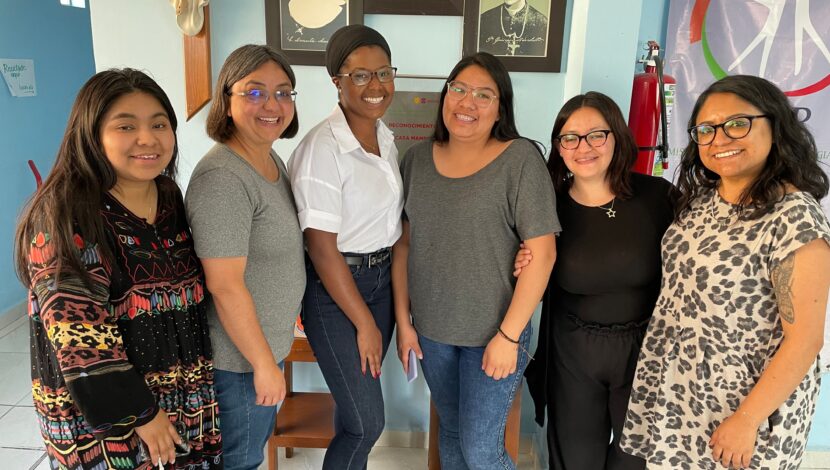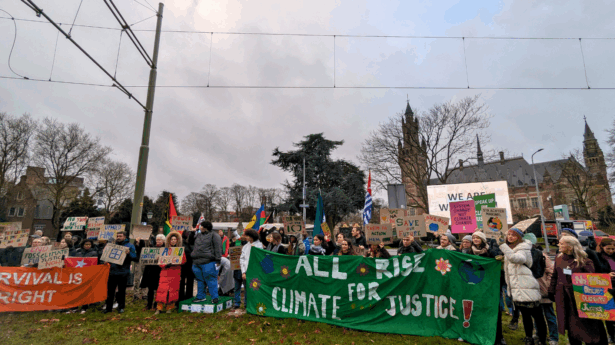The Unitarian Universalist Service Committee advances human rights through grassroots collaborations.
Casa Mambré: A Home of SMR

April 27, 2023
In the neighborhood of Iztapalapa in Mexico City, is the Casa Mambré shelter, managed by Scalabrinianas Mission with Migrants and Refugees (SMR). However, Casa Mambré is more than just a shelter: it is a home for women, men, and children who have made the difficult decision to leave their own homes in search of safer and healthier opportunities. Today, the shelter houses more than 30 people at a time, and the SMR team that organizes and manages it provides residents with psychosocial support and counseling, education, physical health support, and much more. Above all, Casa Mambré joins the 30-year legacy of the Mission of the Missionary Sisters of St. Charles Borromeo Scalabrinians to provide accompaniment to people in situations of migration in Mexico.
The Shelter
In 1985, the Scalabrinian Sisters arrived in the city of Tijuana, Baja California, in northern Mexico, and in 1994, at the request of the local church, they inaugurated the Madre Asunta Center, a shelter that serves migrant, displaced, and refugee women and children.
In 2016, SMR opened a new shelter in Mexico City’s Guerrero neighborhood and named it Casa Mambré. The shelter differed from many others in the city because it opened its doors to people who needed longer-term shelter than is normally offered. Most migrant shelters limit stays to six to eight weeks to allow new people to receive services while previous residents continue to their final destinations, usually to the United States. However, in Casa Mambré the stay of residents can be three to six months or even up to a year, depending on their situations and needs. Residents of Casa Mambré, in general, are people who were victims of one or more forms of violence: survivors of crimes committed in Mexico (sexual violence, kidnapping, human trafficking, among others), people subject to international protection, refugees and unaccompanied minors.
During their stay at Casa Mambré, residents receive psychosocial support and individualized advice from an on-site psychologist. This support begins during admission, when each new resident is interviewed and their mental health assessed. From that assessment, the psychologist accompanies people to group meetings and individual counseling so that they learn to live with their losses and recover from their traumas.
The Casa Mambré psychologist stated: “When we identify that there is severe anxiety or depression, [the Casa Mambré’s social worker] and I connect with the psychiatric hospital nearby to guarantee adequate care for their mental health. In cases in which medication is required, residents are accompanied so that they receive specialized care. ”
In addition to counseling support, the Casa Mambré team offers workshops to residents on personal care, family well-being, and recognizing and treating signs of harassment and abuse. The team also supports residents in resolving problems and disagreements through regular mediation circles where residents meet and receive support to talk to each other.
The psychologist spoke about this: “We also hold circles once a month unless they are needed more often […] many times people come to us and mention their difficulties in living in community with each other. So, when this happens, we identify the points on which we need to work and we decide to hold a specialized circle—for example, for women, men, children, teens, or a mixture […] What we look for in these circles is not to define rules, but rather to guide the group in developing its own strategies. We ask them, ‘What do you think we could we do to resolve this?’ and then they come up with their own strategies. And that’s when we see changes.”
The Casa Mambré team also works to provide residents with physical health support and community integration. Resident children and teens enroll in school upon arrival and the team helps them excel, even when Spanish is not their first language. As the demographics of people migrating through Mexico change, so too do the demographics of Casa Mambré’s residents. The shelter is home to people from all over the world, including people from Central America, the Democratic Republic of Congo, China, and more. As such, the shelter not only gives residents the opportunity to rest and restart during their travels, but also allows people to meet and learn from others in a way they may not have before.
This becomes evident through food. The chef at Casa Mambré is responsible for preparing delicious and healthy meals for all residents. This means that she takes into account dietary restrictions such as diabetes or vegetarianism while listening to the feedback she receives from residents. Vegetables are often difficult for both adult and children residents, so the chef becomes crafty. She has developed creative ways to hide vegetables in more appealing foods, such as putting grated carrots in meat patties to encourage their consumption. She also has a suggestion box in the dining room that residents can use to let her know if they like a meal or prefer to eat something different.
In addition to healing through food, Casa Mambré has the support of the local health center and a dentist to provide health services to residents. Therefore, residents who need specific therapy or medication can be adequately cared for and prenatal care can be provided. The team also works closely with the nearby Emiliano Zapata hospital to provide the most comprehensive care possible.
Casa Mambré’s legal team provides support to residents navigating Mexico’s immigration processes, including helping individuals and families apply for asylum and refugee status and obtain the necessary documents. In addition, legal support includes accompanying survivors in reporting crimes and seeking justice, as well as submitting marriage licenses, birth certificates, and more.
The integrated accompaniment of the team to the residents does not stop there. As mentioned by the Monitoring and Evaluation Coordinator, “For us it is very important that the people in migration really feel hosted, but with dignity. It is really important for us to know the residents’ opinions on everything from the food and the support they receive from the social worker, to if they are happy [and] if they feel safe in Casa Mambré because yes, it’s a shelter, but that’s why we put the name Casa Mambré. We want residents to feel—well, not at home—but like they are in a home. ”
And the feeling of home really shows in every aspect of the shelter. Before each meal, the children of Casa Mambré give thanks together to bless the food before eating and pray for each other. Additionally, during the COVID-19 pandemic shutdown, the Casa Mambré team instituted creative measures to keep residents entertained and spiritually elevated. For example, every Friday, the team and residents organized different events such as dances, costume parties, and more. In addition, each resident youth was assigned a “parent” if they did not already have one at the shelter. The parent was an adult resident who acted as a mentor to the child and assumed responsibility for him or her. This is part of what Sister Lidia Silva de Souza, supervisor of Casa Mambré, expressed as an integral goal of Casa Mambé’s work and SMR in general: To ensure that people “feel wanted, loved” to heal. “That is the most important thing for someone in the process of migrating—to be heard, looked at with dignity.”
Residents also regularly participate in tours of the Iztapalapa neighborhood with the Casa Mambré team. For example, the team organizes trips to local pools, organizes game days, and takes residents to movie screenings.
The psychologist mentioned that “[recently], there was a movie screening at night, and we all went. We went in the van, and everyone stayed there, and it was really nice. We also connected with the Cine Club so that whenever there is a screening nearby, we can go and be comfortable, be close to the shelter, and residents don’t have to pay for a ticket or transportation or anything.”
The Move
From the opening of Casa Mambré in 2016 until January 2021, the shelter was located in a large house in the Guerrero neighborhood, in downtown Mexico City, and provided many of the services provided by the current location. However, the building that housed Casa Mambré was old and the rent was expensive. Although SMR was receiving some support from an international non-governmental organization (INGO) to help with the cost of rent, the space was unsustainable because the owner did not want to undertake the necessary renovations to the building.
In 2021, there was a magnitude 7.1 earthquake and 92 aftershocks in Acapulco that shook much of the country, including Mexico City. In addition, the same year there was substantial rainfall in Mexico City. The two events together caused the roof to begin to collapse over the second floor where the men’s dormitory was located. As such, the team had to rethink the shelter configuration. The administrative offices that were on the main floor of Casa Mambré were moved to a separate location in Nezahualcóyotl (a town on the eastern outskirts of Mexico City) and the men’s dormitory replaced them on the first floor. Later, through a relationship with a religious congregation that had a building in the Iztapalapa neighborhood, SMR decided to also move Casa Mambré.
“Honestly, we all were very scared to go there because it’s Iztapalapa. It’s very stigmatized because […] people say it’s super dangerous, that you will get assaulted. But we decided to move Casa Mambré in January 2022 to Iztapalapa and we found that it was really good to move [there] because the people [there] are conscious about civil society and causes, and we found that there are many people in migration living in Iztapalapa,” included the Monitoring and Evaluation Coordinator.
Casa Mambré’s work in Iztapalapa continues to add to the overall work done by SMR in Mexico City to protect and accompany people on the move. This also includes SMR’s work with human rights defenders working across the country to defend, protect and promote the rights of people on migration.
Casa Mambré’s impact can best be seen through its photographic project. Each time new arrivals enter the shelter, they take a photo during admission. Then, when they leave months later, they take another photo before leaving. Sister Lidia stated, “…it is so important that we have the photo of the day they arrive and the photo of the day they leave because some people arrive very mistreated both physically and psychologically. People come very depressed, you can see it in their face—when they leave, they are smiling, they have gained weight.”
UUSC is proud to support organizations like SMR that protect people’s right to move, as well as their right to stay. To learn more about SMR’s work in Mexico, visit their website.
Image Credit: UUSC

